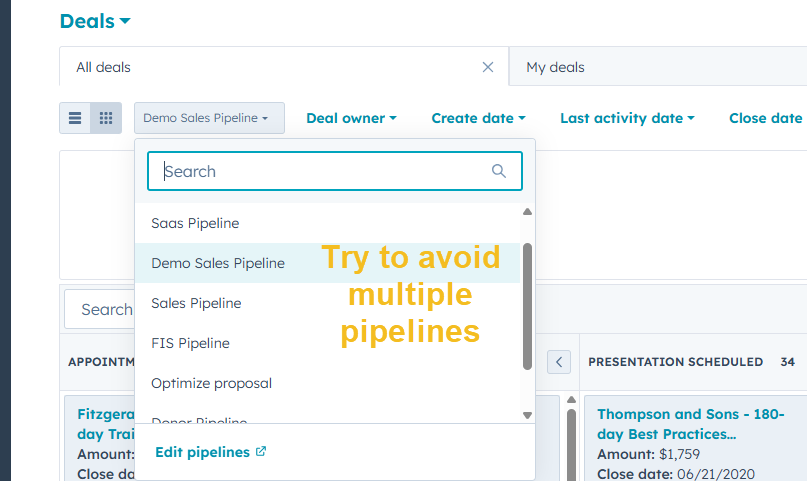If you’ve ever opened your HubSpot deals dashboard and felt overwhelmed, you’re not alone. Most pipelines fail because they’re built in ways that don’t match how sales actually works.
There are three big reasons pipelines break down. First, too many deal stages. Second, no closed lost reasons. Third, multiple pipelines that make reporting a nightmare. Fix these, and your sales team will actually use the pipeline you’ve built.
Simplifying Your Deal Stages
Too many stages create confusion. Some companies add ten or more steps, thinking more detail means more accuracy. In reality, it just slows reps down and makes reporting impossible.

A simple, standardized set of stages works best. Discovery, Demo, Quote, Won, and Lost. That’s enough to show where a deal is without overcomplicating things.
One client came to us with five separate pipelines, each with its own version of stages. We helped them consolidate into a single pipeline with standardized steps. Suddenly, sales adoption improved, reports made sense again, and leadership had a clear view of revenue.
The Importance of Closed Lost Reasons
If your pipeline has no closed lost reasons, you’re missing the story behind why deals don’t close. Was it pricing? A competitor? Bad timing? Without this insight, you can’t improve your sales process.
In HubSpot, make closed lost reasons a required field. Set up clear categories like Pricing, Competitor, Timing, or Not a Fit. Then review them quarterly. This one step turns “we lost the deal” into actionable data.
One Pipeline vs Many Pipelines
This is one of the most common mistakes we see. Companies create multiple pipelines for different product lines, regions, or services. On the surface it seems logical, but in practice it destroys reporting.
When you have multiple pipelines, you need to combine data across each one to see the full revenue picture. Revenue forecasting becomes complicated as now have to program each pipeline into your reports – a step that is often forgotten!
Instead, build one pipeline and use a custom property like Service Type or Region. Make that property required when creating a deal. Now you can segment your reports by that field without splintering your pipeline. It keeps things clean, consistent, and easy to track.

Building a Pipeline That Sales Teams Actually Use
A pipeline only works if your sales team uses it. That means keeping it simple. A handful of clear stages, required properties for key fields like Amount and Close Date, and one pipeline that everyone follows.
When your pipeline is clean, sales reps know what’s expected of them. Managers get accurate reports. Leadership trusts the forecasts. Everyone wins.
Conclusion: Clean Pipelines Drive Better Revenue Insights
A messy pipeline doesn’t just frustrate your reps. It damages your ability to forecast, spot trends, and make good decisions. By simplifying stages, adding closed lost reasons, and sticking to one pipeline, you’ll have a system that sales actually uses.
If you want accurate reports, stronger adoption, and a pipeline that tells the truth about your revenue, it starts with cleaning up the basics.
FAQs
How many deal stages should a HubSpot pipeline have?
Most teams work best with five to seven stages. Too many creates confusion, while too few leaves gaps in the process.
Why should I add closed lost reasons to my pipeline?
They give you visibility into why deals fail. With categories like pricing, timing, or competition, you can adjust your strategy based on real data.
Is it ever okay to have multiple pipelines in HubSpot?
Only if you have radically different sales processes, such as SMB vs enterprise. Most of the time, one pipeline with a custom property for product or region works better.
What properties should be required in HubSpot deals?
At minimum: Amount, Close Date, Deal Owner, and Closed Lost Reason. These ensure your reports and forecasts are accurate.
How can I improve sales adoption of my pipeline?
Keep it simple, require the right fields, and make sure reps see the value. If they know leadership relies on pipeline data for forecasting, they’ll take it seriously.



